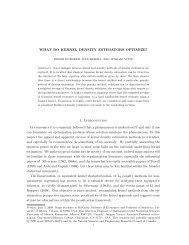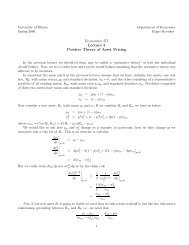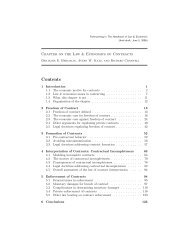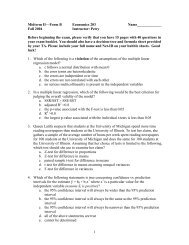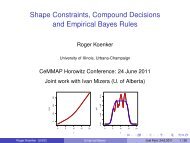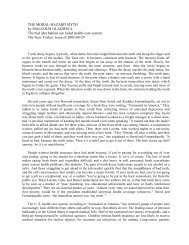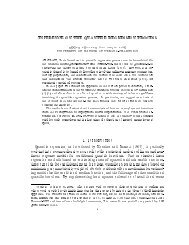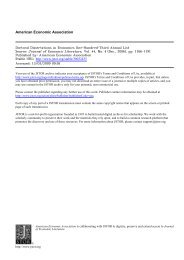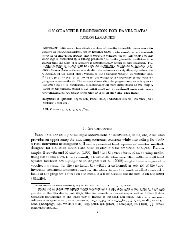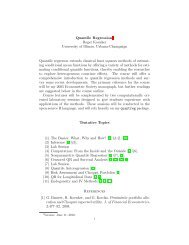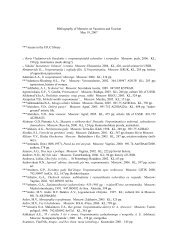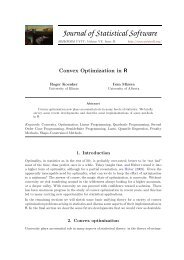Cross-Asset Speculation in Stock Markets∗ - Econometrics at Illinois ...
Cross-Asset Speculation in Stock Markets∗ - Econometrics at Illinois ...
Cross-Asset Speculation in Stock Markets∗ - Econometrics at Illinois ...
Create successful ePaper yourself
Turn your PDF publications into a flip-book with our unique Google optimized e-Paper software.
3, specul<strong>at</strong>ive trad<strong>in</strong>g <strong>in</strong>tensities on <strong>in</strong>tr<strong>in</strong>sic <strong>in</strong>form<strong>at</strong>ion are characterized byb ∼ (AΣ e A ′ ) −1/2 Σ 1/2u .In sharp contrast, with unobservable prices, Corollary 1 immedi<strong>at</strong>ely reveals th<strong>at</strong> trad<strong>in</strong>g str<strong>at</strong>egiesare not proportional to (AΣ e A ′ ) −1/2 .B<strong>Cross</strong>-asset correl<strong>at</strong>ionsWe now derive a result of the unravel<strong>in</strong>g by market makers of the filter<strong>in</strong>g by traders of order flow.Proposition 5 In the fully symmetric, two-specul<strong>at</strong>or observable price environment of Proposition3, the covariance m<strong>at</strong>rix of price changes, λΓΨΓ ′ λ ′ , is <strong>in</strong>dependent of Σ u , i.e., of the distributionalproperties of liquidity trade. Only the variance-covariance structure of the <strong>in</strong>nov<strong>at</strong>ions to assetvalues, Σ e , affects the correl<strong>at</strong>ion structure of price changes.The economic force driv<strong>in</strong>g this result is th<strong>at</strong> if the correl<strong>at</strong>ion structure of noise trade affected thecorrel<strong>at</strong>ion structure of prices, then prices would be system<strong>at</strong>ically driven by processes other thanvalue—market makers would be system<strong>at</strong>ically mispric<strong>in</strong>g stocks—and specul<strong>at</strong>ors would exploitthis. Formally, us<strong>in</strong>g b ∼ Σ 1/2u , we have th<strong>at</strong> the <strong>in</strong>ner product of net order flow, Ψ = bAΣ e A ′ b ′ +Σ u ∼ Σ u ; and λ ∼ Σ −1/2uunw<strong>in</strong>ds the correl<strong>at</strong>ion structure of liquidity trade, leav<strong>in</strong>g only theimpact of the variance-covariance structure of <strong>in</strong>tr<strong>in</strong>sic <strong>in</strong>form<strong>at</strong>ion. Our numerical <strong>in</strong>vestig<strong>at</strong>ions<strong>in</strong>dic<strong>at</strong>e th<strong>at</strong> this result extends to arbitrary numbers of specul<strong>at</strong>ors, and to asymmetric sett<strong>in</strong>gs.We next prove th<strong>at</strong> <strong>in</strong> fully symmetric environments, the str<strong>at</strong>egic behavior by specul<strong>at</strong>orscauses price changes to be more correl<strong>at</strong>ed than the underly<strong>in</strong>g fundamentals; and our numerical<strong>in</strong>vestig<strong>at</strong>ions strongly suggest th<strong>at</strong> this result extends more generally to asymmetric environments.Proposition 6 In the fully symmetric, two-specul<strong>at</strong>or observable price environment of Proposition3, price changes (returns) are more correl<strong>at</strong>ed than the underly<strong>in</strong>g fundamentals. For smallcorrel<strong>at</strong>ions <strong>in</strong> fundamentals, θ, the price change correl<strong>at</strong>ion is approxim<strong>at</strong>ely 5 3 θ.Corollary 1 revealed th<strong>at</strong> <strong>in</strong> symmetric sett<strong>in</strong>gs, unobservable prices cause specul<strong>at</strong>ors to tradeonly on their direct signals; whereas with observable prices, specul<strong>at</strong>ors weight positively their signal15



